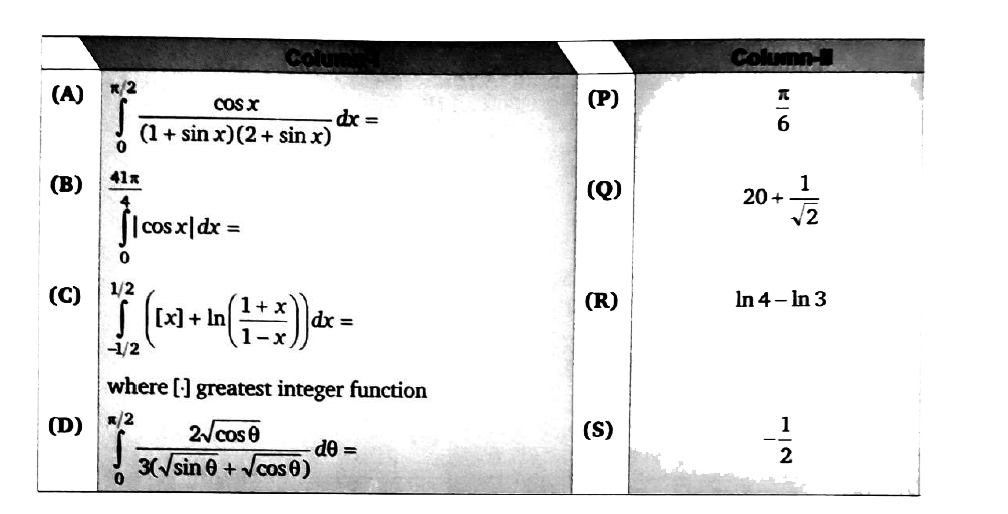Consider the function f(x)andg(x), both defined from R→R
f(x)=x32+1−x∫x0g(t)dtandg(x)=x−∫10f(t)dt, then
The number of points of intersection of f(x)andg(x) is/are:
0
1
32
does not exist
The correct Answer is:B
Step by step video solution for Consider the function f (x) and g (x), both defined from R to R f (x) = (x ^(3))/(2 )+1 -x int _(0)^(x) g (t) dt and g (x) =x - int _(0) ^(1) f (t) dt, then The number of points of intersection of f (x) and g (x) is/are: by Maths experts to help you in doubts & scoring excellent marks in Class 12 exams.
Updated on:21/07/2023Topper's Solved these Questions
- INDEFINITE AND DEFINITE INTEGRATIONBOOK - VIKAS GUPTA (BLACK BOOK) ENGLISHCHAPTER - INDEFINITE AND DEFINITE INTEGRATIONEXERCISE - EXERCISE (MATCHING TYPE PROBLEMS)
3 Videos
- INDEFINITE AND DEFINITE INTEGRATIONBOOK - VIKAS GUPTA (BLACK BOOK) ENGLISHCHAPTER - INDEFINITE AND DEFINITE INTEGRATIONEXERCISE - EXERCISE (SUBJECTIVE TYPE PROBLEMS)
27 Videos
- INDEFINITE AND DEFINITE INTEGRATIONBOOK - VIKAS GUPTA (BLACK BOOK) ENGLISHCHAPTER - INDEFINITE AND DEFINITE INTEGRATIONEXERCISE - EXERCISE (ONE OR MORE THAN ONE ANSWER IS/ARE CORRECT)
16 Videos
- HYPERBOLABOOK - VIKAS GUPTA (BLACK BOOK) ENGLISHCHAPTER - HYPERBOLAEXERCISE - Exercise-4 : Subjective Type Problems
3 Videos
- INVERSE TRIGONOMETRIC FUNTIONS BOOK - VIKAS GUPTA (BLACK BOOK) ENGLISHCHAPTER - INVERSE TRIGONOMETRIC FUNTIONS EXERCISE - Exercise-5 : Subjective Type Problems
5 Videos
Similar Questions

View Solution∫x+(cos−13x)2√1−9x2dx=1k1(√1−9x2+(cos−13x)k2)+c, then k21+k22= (where C is an arbitrary constnat. )
View Solution∫dx(1+√x)8=−13(1+√x)k1+27(1+√x)k2+C, then:
View SolutionLet y=mx+c be a common tangent to x216−y29=1andx24+y23=1, then find the value of m2+c2.
View SolutionThe complete set of values of x satisfying the inequality sin−1(sin5)>x2−4x is (2−√λ−2π,2+√λ−2π), then λ=
View SolutionSuppose f(x)andg(x) are two continuous functions defined for 0≤x≤1.Given, f(x)=∫10ex+1.f(t)dtandg(x)=∫10ex+1⋅g(t)dt+x The value of f(1) equals
View Solutionf(x)=(x^(2))/(1+x^(3));g(t)=int f(t)dt. If g(1)=0 then g(x) equals-
View Solutionf(x):[0,5]→R,F(x)=∫x0x2g(x), f(1) = 3
g(x) = ∫x1f(t)dt then correct choice is
View SolutionLet f(x)=∫x3x2dtlnt for x>1andg(x)=∫x1(2t2−lnt)f(t)dt(x>1), then:
View SolutionIf f(x)=∫g(x)0dt√1+t3,g(x)=∫cosx0(1+sint)2dt, then the value of f'(π2) is equal to:
View SolutionGiven a function 'g' continous everywhere such that ∫10g(t)dt=2andg(1)=5. If f(x)=12∫x0(x−t)2g(t)dt, then the vlaue of f'(1)−f'(1) is:
View SolutionConsider the function f(x)andg(x), both defined from R→R
f(x)=x32+1−x∫x0g(t)dtandg(x)=x−∫10f(t)dt, then
minimum value of f(x) is:
View SolutionConsider the function f(x)andg(x), both defined from R→R
f(x)=x32+1−x∫x0g(t)dtandg(x)=x−∫10f(t)dt, then
The number of points of intersection of f(x)andg(x) is/are:
View SolutionConsider the function f(x)andg(x), both defined from R→R
f(x)=x32+1−x∫x0g(t)dtandg(x)=x−∫10f(t)dt, then
The area borunded by g(x) with co-ordinate axes is (in square units):
View SolutionLet f(x)=∫x0g(t)dt , where g is a non - zero even function . If f(x+5)=g(x) , then ∫x0f(t)dt equals :
View Solutionf(x):[0,5]→R,F(x)=∫x0x2g(x), f(1) = 3
g(x) = ∫x1f(t)dt then correct choice is
View Solution

